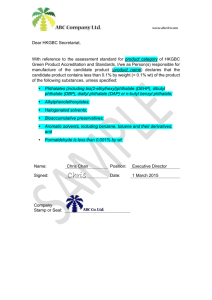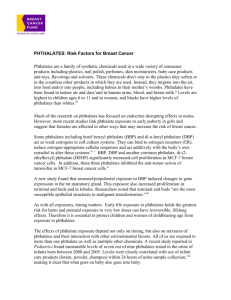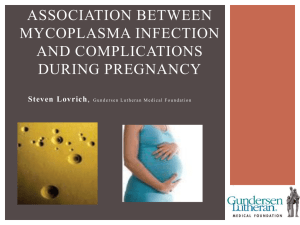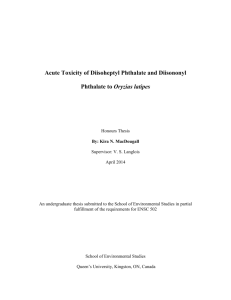Powerpoint template for scientific posters
advertisement
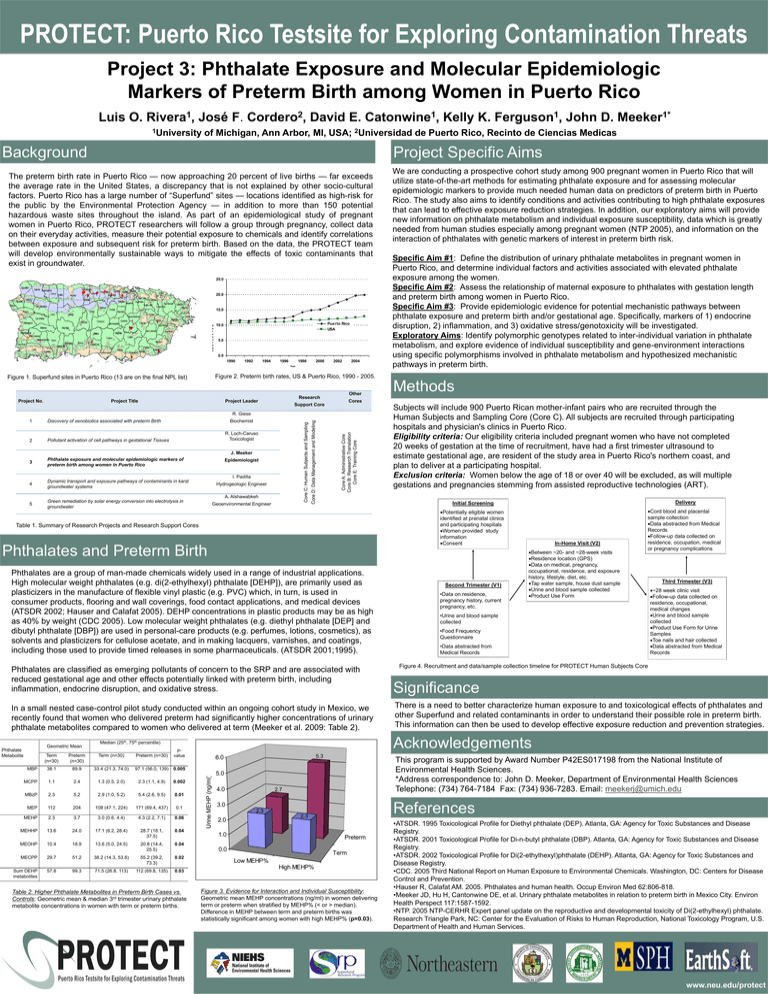
PROTECT: Puerto Rico Testsite for Exploring Contamination Threats Project 3: Phthalate Exposure and Molecular Epidemiologic Markers of Preterm Birth among Women in Puerto Rico Luis O. Rivera1, José F. Cordero2, David E. Catonwine1, Kelly K. Ferguson1, John D. Meeker1* 1University of Michigan, Ann Arbor, MI, USA; 2Universidad de Puerto Rico, Recinto de Ciencias Medicas Background Project Specific Aims The preterm birth rate in Puerto Rico — now approaching 20 percent of live births — far exceeds the average rate in the United States, a discrepancy that is not explained by other socio-cultural factors. Puerto Rico has a large number of “Superfund” sites — locations identified as high-risk for the public by the Environmental Protection Agency — in addition to more than 150 potential hazardous waste sites throughout the island. As part of an epidemiological study of pregnant women in Puerto Rico, PROTECT researchers will follow a group through pregnancy, collect data on their everyday activities, measure their potential exposure to chemicals and identify correlations between exposure and subsequent risk for preterm birth. Based on the data, the PROTECT team will develop environmentally sustainable ways to mitigate the effects of toxic contaminants that exist in groundwater. 25.0 20.0 15.0 P e r c e n t a g e Puerto Rico USA 10.0 5.0 0.0 1990 1992 1994 1996 1998 2000 2002 2004 Year Project Title Other Research Project Leader Support Core Pollutant activation of cell pathways in gestational Tissues J. Meeker 3 Phthalate exposure and molecular epidemiologic markers of preterm birth among women in Puerto Rico Epidemiologist I. Padilla 4 Dynamic transport and exposure pathways of contaminants in karst groundwater systems Hydrogeologic Engineer A. Alshawabkeh 5 Green remediation by solar energy conversion into electrolysis in groundwater Geoenvironmental Engineer Core A: Administrative Core Core B: Research Translation Core E: Training Core R. Loch-Caruso Toxicologist Core D: Data Management and Modeling Biochemist Core C: Human Subjects and Sampling 2 Discovery of xenobiotics associated with preterm Birth Methods Cores R. Giese 1 Specific Aim #1: Define the distribution of urinary phthalate metabolites in pregnant women in Puerto Rico, and determine individual factors and activities associated with elevated phthalate exposure among the women. Specific Aim #2: Assess the relationship of maternal exposure to phthalates with gestation length and preterm birth among women in Puerto Rico. Specific Aim #3: Provide epidemiologic evidence for potential mechanistic pathways between phthalate exposure and preterm birth and/or gestational age. Specifically, markers of 1) endocrine disruption, 2) inflammation, and 3) oxidative stress/genotoxicity will be investigated. Exploratory Aims: Identify polymorphic genotypes related to inter-individual variation in phthalate metabolism, and explore evidence of individual susceptibility and gene-environment interactions using specific polymorphisms involved in phthalate metabolism and hypothesized mechanistic pathways in preterm birth. Figure 2. Preterm birth rates, US & Puerto Rico, 1990 - 2005. Figure 1. Superfund sites in Puerto Rico (13 are on the final NPL list) Project No. We are conducting a prospective cohort study among 900 pregnant women in Puerto Rico that will utilize state-of-the-art methods for estimating phthalate exposure and for assessing molecular epidemiologic markers to provide much needed human data on predictors of preterm birth in Puerto Rico. The study also aims to identify conditions and activities contributing to high phthalate exposures that can lead to effective exposure reduction strategies. In addition, our exploratory aims will provide new information on phthalate metabolism and individual exposure susceptibility, data which is greatly needed from human studies especially among pregnant women (NTP 2005), and information on the interaction of phthalates with genetic markers of interest in preterm birth risk. Table 1. Summary of Research Projects and Research Support Cores Phthalates and Preterm Birth Phthalates are a group of man-made chemicals widely used in a range of industrial applications. High molecular weight phthalates (e.g. di(2-ethylhexyl) phthalate [DEHP]), are primarily used as plasticizers in the manufacture of flexible vinyl plastic (e.g. PVC) which, in turn, is used in consumer products, flooring and wall coverings, food contact applications, and medical devices (ATSDR 2002; Hauser and Calafat 2005). DEHP concentrations in plastic products may be as high as 40% by weight (CDC 2005). Low molecular weight phthalates (e.g. diethyl phthalate [DEP] and dibutyl phthalate [DBP]) are used in personal-care products (e.g. perfumes, lotions, cosmetics), as solvents and plasticizers for cellulose acetate, and in making lacquers, varnishes, and coatings, including those used to provide timed releases in some pharmaceuticals. (ATSDR 2001;1995). Subjects will include 900 Puerto Rican mother-infant pairs who are recruited through the Human Subjects and Sampling Core (Core C). All subjects are recruited through participating hospitals and physician's clinics in Puerto Rico. Eligibility criteria: Our eligibility criteria included pregnant women who have not completed 20 weeks of gestation at the time of recruitment, have had a first trimester ultrasound to estimate gestational age, are resident of the study area in Puerto Rico's northern coast, and plan to deliver at a participating hospital. Exclusion criteria: Women below the age of 18 or over 40 will be excluded, as will multiple gestations and pregnancies stemming from assisted reproductive technologies (ART). Initial Screening Delivery Potentially eligible women identified at prenatal clinics and participating hospitals Women provided study information Consent Cord blood and placental sample collection Data abstracted from Medical Records Follow-up data collected on residence, occupation, medical or pregnancy complications Second Trimester (V1) •Data on residence, pregnancy history, current pregnancy, etc. In-Home Visit (V2) Between ~20- and ~28-week visits Residence location (GPS) Data on medical, pregnancy, occupational, residence, and exposure history, lifestyle, diet, etc. Tap water sample, house dust sample Urine and blood sample collected Product Use Form •Urine and blood sample collected •Food Frequency Questionnaire •Data abstracted from Medical Records Third Trimester (V3) ~28 week clinic visit Follow-up data collected on residence, occupational, medical changes Urine and blood sample collected Product Use Form for Urine Samples Toe nails and hair collected Data abstracted from Medical Records Figure 4. Recruitment and data/sample collection timeline for PROTECT Human Subjects Core Phthalates are classified as emerging pollutants of concern to the SRP and are associated with reduced gestational age and other effects potentially linked with preterm birth, including inflammation, endocrine disruption, and oxidative stress. Significance In a small nested case-control pilot study conducted within an ongoing cohort study in Mexico, we recently found that women who delivered preterm had significantly higher concentrations of urinary phthalate metabolites compared to women who delivered at term (Meeker et al. 2009: Table 2). There is a need to better characterize human exposure to and toxicological effects of phthalates and other Superfund and related contaminants in order to understand their possible role in preterm birth. This information can then be used to develop effective exposure reduction and prevention strategies. Term (n=30) Preterm (n=30) Term (n=30) Preterm (n=30) pvalue MBP 38.1 89.9 33.4 (21.3, 74.0) 97.1 (56.0, 139) 0.005 MCPP 1.1 2.4 1.3 (0.5, 2.0) 2.3 (1.1, 4.9) 0.002 MBzP 2.3 5.2 2.9 (1.0, 5.2) 5.4 (2.6, 9.5) 0.01 MEP 112 204 108 (47.1, 224) 171 (69.4, 437) 0.1 MEHP 2.3 3.7 3.0 (0.6, 4.4) 4.3 (2.2, 7.1) 0.06 MEHHP 13.6 24.0 17.1 (6.2, 28.4) 28.7 (18.1, 37.5) 0.04 20.8 (14.4, 25.5) 0.04 MEOHP 10.4 18.9 Acknowledgements 13.6 (5.0, 24.5) 5.3 6.0 Urine MEHP (ng/ml) Geometric Mean Phthalate Metabolite Median (25th, 75th percentile) 5.0 4.0 2.7 29.7 51.2 38.2 (14.3, 53.8) 55.2 (39.2, 73.3) 0.02 Sum DEHP metabolites 57.8 99.3 71.5 (26.8, 113) 112 (69.8, 135) 0.03 Table 2. Higher Phthalate Metabolites in Preterm Birth Cases vs. Controls: Geometric mean & median 3rd trimester urinary phthalate metabolite concentrations in women with term or preterm births. References 3.0 2.3 2.3 2.0 1.0 Preterm 0.0 MECPP This program is supported by Award Number P42ES017198 from the National Institute of Environmental Health Sciences. *Address correspondence to: John D. Meeker, Department of Environmental Health Sciences Telephone: (734) 764-7184 Fax: (734) 936-7283. Email: meekerj@umich.edu Term Low MEHP% High MEHP% Figure 3. Evidence for Interaction and Individual Susceptibility: Geometric mean MEHP concentrations (ng/ml) in women delivering term or preterm when stratified by MEHP% (< or > median). Difference in MEHP between term and preterm births was statistically significant among women with high MEHP% (p=0.03). •ATSDR. 1995 Toxicological Profile for Diethyl phthalate (DEP). Atlanta, GA: Agency for Toxic Substances and Disease Registry. •ATSDR. 2001 Toxicological Profile for Di-n-butyl phthalate (DBP). Atlanta, GA: Agency for Toxic Substances and Disease Registry. •ATSDR. 2002 Toxicological Profile for Di(2-ethylhexyl)phthalate (DEHP). Atlanta, GA: Agency for Toxic Substances and Disease Registry. •CDC. 2005 Third National Report on Human Exposure to Environmental Chemicals. Washington, DC: Centers for Disease Control and Prevention. •Hauser R, Calafat AM. 2005. Phthalates and human health. Occup Environ Med 62:806-818. •Meeker JD, Hu H, Cantonwine DE, et al. Urinary phthalate metabolites in relation to preterm birth in Mexico City. Environ Health Perspect 117:1587-1592. •NTP. 2005 NTP-CERHR Expert panel update on the reproductive and developmental toxicity of Di(2-ethylhexyl) phthalate. Research Triangle Park, NC: Center for the Evaluation of Risks to Human Reproduction, National Toxicology Program, U.S. Department of Health and Human Services. www.neu.edu/protect
